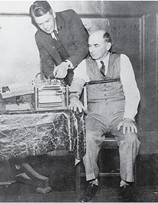THE LIE DETECTOR TEST REVISITED A Great Example of Junk Science
MORTON E. TAVEL

Although the polygraph can be useful in coercing confessions, it is based on scientifically implausible assumptions of accuracy and is biased against the innocent. The scientific community justly considers it pseudoscience, and it should be abandoned.
Recently I came across one of television’s true crime programs that presented a provocative example from actual case files: A woman had been brutally murdered in her apartment. Her former boyfriend with whom she had recently had a vigorous altercation became the leading murder suspect. During the investigation, this man was “offered” a polygraph (lie detector) test in the attempt to establish his likely guilt or innocence. He agreed to be tested and was found to have “failed,” thus presumably indicating his likely guilt.
Despite this result, the evidence presented at the trial was deemed insufficient for a guilty verdict, and he was acquitted. Convinced that the polygraph test was accurate, his local community made him a pariah; he was shunned and even threatened with bodily harm. Several months later, however, another man, the actual murderer, was apprehended and convicted. Thus at least for this first suspect, despite his ordeal, the story had a satisfactory ending, and the lie detector test itself proved inaccurate and misleading. This outcome leads to an obvious question: How often does “lie detection by machine” prove false?
Much of the American public seems to be convinced that the “lie detector” is valid, as indicated by its ubiquitous use in “whodunit” literature and on television crime, psychology, talk, and news shows.
Much of the American public seems to be convinced that the “lie detector” is valid, as indicated by its ubiquitous use in “whodunit” literature and on television crime, psychology, talk, and news shows. After all, faced with such an avalanche of widespread approbation, who could doubt the validity of such a test? Supporting this illusion is the fact that federal, state, and local police departments and law enforcement agencies across the United States are generally avid proponents of this method.
But let’s take a closer look at this subject. Questions about the accuracy of this test should be amenable to modern scientific methods. Interestingly, this challenge is strikingly similar to those we face regularly as medical researchers and practitioners when we evaluate various tests in the attempt to establish the presence or absence of many diseases. Through this lens, therefore, I can provide some insight on a method that is often uncritically analyzed.
The Procedure and Its History
The “lie detector” test has been used for nearly a century, and it employs a “polygraph,” which, during questioning, continuously records an examinee’s blood pressure, respiration, pulse rate, and skin resistance (an indirect measure of perspiration).
The usual format compares responses to “relevant” questions with those of “control” questions. The control questions are designed to control for the effect of the generally threatening nature of relevant questions. Control questions concern misdeeds that are similar to those being investigated, but refer to the subject’s past and are usually broad in scope; for example, “Have you ever betrayed anyone who trusted you?”
A person who is telling the truth is assumed to fear control questions more than relevant questions. This is because control questions are designed to arouse a subject’s concern about their past truthfulness, while relevant questions ask about a crime of which they are suspected. A pattern of greater physiological response to relevant questions than to control questions leads to a diagnosis of “deception.” Greater response to control questions leads to a judgment of no deception. If no difference is found between relevant and control questions, the test result is considered inconclusive.